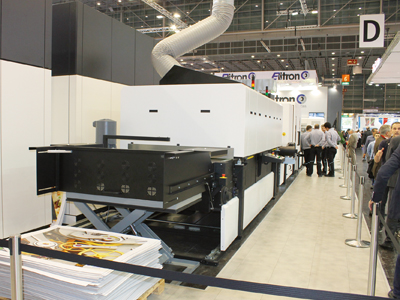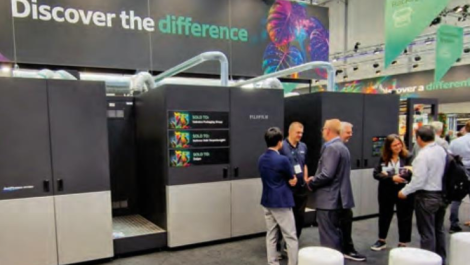Durst introduced the Rho 130 SPC press for corrugated printing at drupa
Digital print technology has made significant inroads in the last couple of years into folding cartons and flexible packaging. Now comes the turn of the vast corrugated sector, and this was one of the biggest themes at drupa this year. By Neel Madsen.
As if by magic, one press manufacturer after another announced at drupa that they had developed new technology for digital printing of corrugated substrates, more specifically single-pass inkjet post-print applications using water-based inks. While there have been options for printing on corrugated substrates on the market for quite some time, with flatbed printers from HP Scitex, Xanté and Inca Digital, we now see a swathe of industrial-sized sheetfed presses entering the arena.
The demands for reduced lead times and just-in-time delivery are impacting all areas of the packaging chain. This is combined with changing consumer buying patterns and the need to respond quickly to new trends, which means that brands are constantly looking to gain advantage and stand out on shelf. Internet retailing has put a different spin on the job of the corrugated box, as has the rise in the use of shelf-ready packaging. At the same time, high print quality is of the essence.
‘The corrugated board market is one of the largest untapped opportunities available for our customers,’ said G Scott Wood, senior product manager, EFI Inkjet. ‘Overall corrugated packaging has a value of about $130 billion. Very little of that is digitally printed today and there is a lot of room for growth, because brands will ultimately want the advantages digital brings with more affordable versioning and multi-SKU applications and efficient, just-in-time supply chain strategies.’
Fast bullet
Ahead of drupa, EFI had already spoken of its intention to make its mark in corrugated, and of the fact that this would be using a new water-based UV ink technology, enabled in part by the recent acquisition of colourant specialist Rialco in the UK.
Named after the Japanese bullet train, the Nozomi C18000 draws on EFI’s single-pass inkjet imaging system from its Jetrion narrow web presses and Cretaprint ceramic printers. It also utilises the material edge guides (MEG) developed for the company’s VUTEk GS and HS hybrid printer models. The MEGs hold boards in place as they run through the press and its ‘cool’ LED curing technology eliminates heat, which can cause boards to warp.
The press offers a productivity of up to 8100 sqm/hr and can print on boards up to 1.8 x 3 m in size. A double-lane printing feature on the press increases throughput up to 9000 80 x 60 cm boards per hour.
Mr Scott said, ‘At EFI, we estimate that the total addressable market for inkjet printers and ink in the corrugated board space is north of $9 billion per year. That makes it one of the largest market segments we reach across the entire company. Further, it allows the traditional flexo, screen and litho lam producers access to the lucrative segments of versioned, personalised and just-in-time print at high volumes. In other words, what was once a 10,000-piece run of the same material could now be five 2000 piece runs targeted at a geographic, demographic, or chain of stores with additional margin added in for the value.’
Filling the gap
Following its launch last year of the PageWide T1100s press for pre-print liner, HP had made no secret of its intention to fill the final gap in packaging applications by introducing a press for post-print too. And thus at drupa, the company presented another new concept employing its PageWide technology, the C500, also a sheetfed single-pass press.
The inkjet press uses newly developed water-based HP inks and the company’s Corrugated Grip technology, to handle a wide range of media from micro-flute to the double-wall board. Promising a wide colour gamut, the inks are designed for printing on the non-food contact surface of paperboard packaging to comply with global food safety regulations and industry guidelines, including the FDA, EuPIA and the Swiss Ordinance, to produce food compliant packaging.
HP is planning to start testing the HP PageWide C500 press at customer sites in 2017, and it is expected to be commercially available in 2018. A strategic collaboration between HP and Smurfit Kappa is part of the further development of the C500. In the UK, Cepac, which has four sites and is part of the HAS Group, signed up for the press in June.
Durst also moved into the post-print sector with the introduction of the Rho 130 SPC (Single Pass Corrugated) inkjet pressline. This uses Durst Water Technology inks and can be configured with four to six colours to print corrugated board sizes of max 1300 x 2500 mm in up 12 mm thickness, at speeds up 120 m/min (this is equivalent to 9350 sqm/hr). It uses drop on demand printhead technology producing a resolution of up to 800 dpi.
The company said that the press offers the industrial productivity level required to transform this industry. It allows shelving and sales packaging in small and medium-sized job runs to be produced economically, and also makes it possible to create samples, customisation and versioning on demand.
Rethinking the box plant
Screen came to drupa to announce its cooperation with German BHS Corrugated, the world’s leading manufacturer of corrugators with a 50% share of the global market and a turnover of €€373 million in 2015. The two companies have worked together to develop a full roll to sheet production line for box plants by combining Screen’s inkjet technology with BHS’ expertise in this particular market. This can also be retrofitted as an upgrade to existing BHS corrugating lines.
The development of the print engine technology will be done by Screen GP IJC Ltd, a new company set up to include Screen subsidiary Inca Digital and take advantage of its competency in inkjet technology. Printing at widths up to 2.8 m with water-based inks, the 300 m/min inline inkjet printing system is likely to take three years to come to market.
‘We are delighted to forge this cooperation with BHS,’ said Tsuneo Baba, president, Screen GP. ‘By combining our digital printing technologies with BHS’s equally advanced technologies we aim to trigger major innovation in the corrugated industry.’
Award winner
Bobst was one of the first to market with its Digital Press for Corrugated Board, which incorporates Kodak’s Stream inkjet technology and won the 2016 European Digital Press Association (EDP) award in the category Best corrugated printer/solution in June. This has been in beta testing for some time now and is producing live jobs for customers of Model AG, in Switzerland, and Schumacher Packaging, in Germany.
‘The first Bobst digital presses for corrugated board are under testing and evaluation at selected sites in Europe. They are already producing customer orders with these machines. Bobst will communicate the wider availability of these presses in due time. In our view digital print for corrugated will not replace analogue printing, it will be complementary both in the near future and also further down the line,’ commented Paul Stoudmann, group business development at Bobst.
Sun in Bradford
Baltimore-based Sun Automation first introduced its CorrStream range of single pass, water-based presses for corrugated post-print two years ago. The company has just announced that HSG Packaging, in the UK, has successfully completed beta testing of a CorrStream Series 66 press at its facility in Bradford.

A CorrStream Series 66 press has been installed at HSG Packaging in Bradford
‘Everyone knew digital was coming to our industry and we were ready to invest in tomorrow’s technology today,’ said Ben Ginesi, HSG’s managing director. ‘We’ve always been motivated to do things differently and to try change the status quo. After meeting with Sun and learning more about their technology and market expertise, we felt confident their new digital offerings would allow us to offer customers entirely new print services.’
HSG entered beta testing in its production environment in January this year. Sun Automation worked closely with the printing company to resolve any machine kinks and get the printer running real-world applications. By March, HSG was running special corrugated orders successfully.
Mr Ginesi added, ‘This technology allows you to put the power of choice back into the customers’ hands. The possibilities are endless and we are very pleased with where the CorrStream is today and the potential it has in the near future.’






